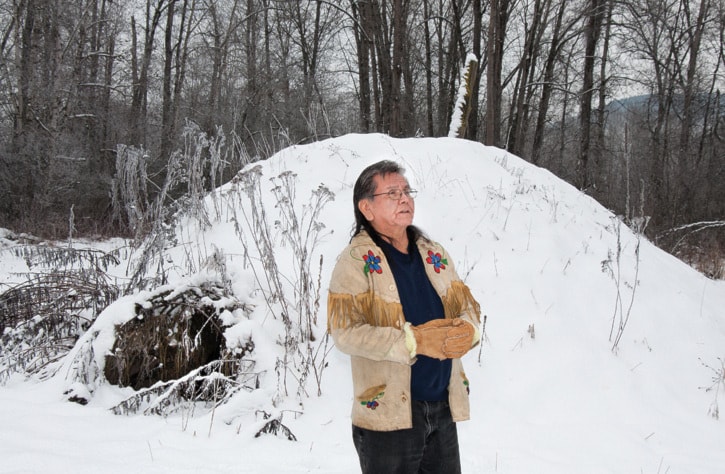Before the attempted takeover of their culture by various churches and governments, First Nations celebrated in winter, but there was no such thing as Christmas.
“A long time ago, it was really Christmas all winter time,” says Louis Thomas, a member of the Neskonlith First Nation. “People would go back into their winter homes – kekulis.”
While they spent summers travelling a broad territory, gathering plants and seeds, fishing and hunting, when the cold arrived, large family units would build their kekulis together.
The temporary villages could run anywhere from 20 to 30 winter homes.
“There was a lot of visiting back and forth to relieve the boredom,” says Thomas, son of late elder Mary Thomas. “I think the kids didn’t really take part, but there was always dancing, storytelling and drumming at night – especially the “chip-tek-wi-la” (legends).”
Thomas says all the legends had a moral to them and were told to children time and time again as part of their training.
“Nobody laughed at someone else, they all laughed together,” he says, pointing out he believes it would have been much the same in the kekulis,
“I believe that was what it was like in the winter homes; that grandmothers would always sneak treats to the kids,” laughs Thomas. “My mom always talked about how the grandmothers would always sneak some extra goodies while the kids were listening to the legends and watching drumming, dancing and singing.”
Winter houses were dug into the earth for warmth, with a roof of branches and a hole in the centre for egress for the men and escape for the smoke from the fire located in the centre of the floor.
Earthen benches for sitting and sleeping ringed the dwelling and it was here that children would lie, listening to the stories and watching the shadows of the singers and dancers.
“The kids would be nestled in nice warm beds of animal furs – beaver, bear, muskrat – and watching the eerie glow of firelight,” he says. “It must have been a sight to see, especially the dancing.”
Most of the stories were about the Coyote, because he was the real trickster, a character, but one who always righted wrongs, says Thomas.
In one legend, Coyote sees Fox taking out his eyes and juggling them. He thinks it is fun and mimics the fox, only to have a raven fly by and steal his eyes.
Coyote begins scrambling around blindly looking for his eyes, but has to settle for two rose berries.
“That’s why today he has red eyes and can’t see so well,” laughs Thomas. “The moral to that is just because you see something, it doesn’t mean you can do it.”
Many First Nations stories are based around the arrival of times or things – St 7ek (sounding a bit like “that-talmoo”) denotes the coming of the people.
Sometimes in the warmth of the kekuli, men would start telling about their hunting feats, which were dramatized with pantomime, Thomas adds. And sometimes those feats became part of a dance.
“For example, if they had fought a bear, it was a real feat to kill a bear,” he says. “You became a ‘mighty hunter. Imagine kids going to sleep dreaming of becoming that.”
Sometimes a professional storyteller would show up, having travelled as far south as the Washington area, east to Alberta and Saskatchewan and to Northern B.C., collecting stories from other First Nation groups.
“He’d gather up the tales and he was given food, clothing and a bed for as long as he stayed,” Thomas says, pointing out the last professional storyteller to visit the Neskonlith was while his grandmother was alive. “He had his little boy with him; always carried him over his shoulder. He spent two or three nights with them.”
Thomas says his grandmother, who was born in 1889, was the last Neskonlith to live in a winter house in Chase, west of the tracks near the Thompson River.
Like most other First Nations people, Thomas and his family celebrate Christian Christmas.
“We adopted the traditions. It was all about kids and I think that is why they readily accepted it,” he says. “That is our culture – looking after the kids.”
After the band had accepted the Roman Catholic tradition and celebrated Christmas, they did so in style.
“Every Christmas, the band would give everyone money from ‘the big R,’” laughs Thomas of the the ‘big rent’ money the radio station paid to have their towers on band land. “There was $500 for toys and $500 for a community dinner in the old log house. It was fun.”
Thomas grew up knowing the Secwepemc language but a lack of practice has made him rusty and he is working on the Voice of the Shuswap to bring back some of the Shuswap traditions.
“We’re losing the language, but there is a slow revival,” he says. “Over the last decade, a number of carols have been translated into Secwepemc.”
Thomas has also modified and shortened some of the legends for his daughters, Christine and Emily, to share on the radio.
And every year, he takes Christina and Emily to find a perfect tree in the bush.
“It’s part of tradition, tromping about in the snow,” he laughs. And instead of the salmon, bannock, berries and fir tree sweetener of earlier times, Thomas and his girls look forward to a turkey dinner with all the trimmings
